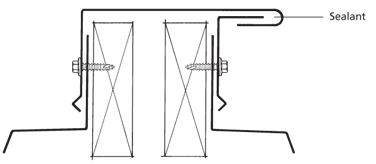Building Expansion Joints
Expansion joints should be designed to accommodate contraction and expansion. Expansion joints should be detailed and constructed to a minimum height of 100 mm above the roof cladding, and curb-type expansion joints should be designed and installed to ensure drainage of the roof and to prevent any damming of water.
Wood curbing secured to the substrate on both sides of an expansion joint should be flashed with a metal capping capable of acting as an expansion joint cover.
Expansion joints have two main designs.
1. A One-piece Expansion Joint to accommodate movement using a central bellows or roll that allows the flashing to be positively fixed on both sides.
2. A two-piece design to accommodate movement by the use of hemmed edges, with sufficient clearance for the expected movement.
Both of these designs are shown as a parapet following the pitch of the roof. Where this is not the case, the top of flashing should have a 10˚ slope as for all other parapet flashings. (See Parapet Cappings).
Metal wall construction joint flashings that are embedded in the wall should be made with a bellows or other means of accommodating movement without fatigue and have a durability of 50 years.
- Log in to post comments


